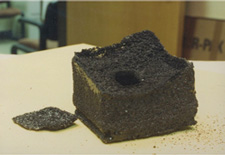It is with sadness that we learned this weekend that Carl Deckard has passed away. Carl was a true industry pioneer in 3D printing. Starting under UT professor Bob Beaman, Carl Deckard was part of an innovative UT team that was developing manufacturing technologies. He reportedly was watching an episode of Star Trek the original series when he thought of how the Star Trek team was able to visualize the transporter. “Beam me up Scottie” was an important element of the science fiction show. It turned out that the transporter special effect was created by arranging colored loose sand so that it resembled the objects being materialized by the transporter. This knowledge triggered an idea in Carl’s head, “what if just like the transporter special effect in Star Trek, he could also use sand to make up objects by arranging them just so?” This thought lead to Carl inventing Selective Laser Sintering as a Master’s Thesis project. He later commercialized the technology in 1987 through his firm DTM. After a few precarious year DTM sold its first machine to Sandia National Labs. DTM was very successful and brought the selective laser sintering technology to market across the globe.

Still today you can see twenty-year-old, low slung blue DTM machines dutifully building parts in service bureaus around the world. The trusty sinterstations are still in use so many years later and reliably spit out thousands of parts. SLS as a technology is special because of this quality. SLA, Stereolithography (and DLP) let us make millions of smooth highly detailed parts for molds and hearing aids. FDM (material extrusion) let us make rough but dimensionally accurate parts reliably. Where SLS really shines is in making ten thousand of something day after day. In applications such as surgical guides, prototyping, dental guides and spare parts SLS can make very detailed, tough parts in their tens and thousands. SLS is reliable and predictable which has made it a bedrock for our industry for decades. Especially in the service bureau world, SLS is the versatile technology that makes millions of different parts day in day out. When we think of mass customization for end use parts SLS is still the most promising technology and a significant part of our total output as an industry. We have Carl to thank for this.

An early SLS part made at UT.
In 2001 Carl sold DTM to 3D Systems. His path in innovation was not done then, however. Carl was a Professor at Clemson and later developed a four-stroke engine with just one moving part. In 2011 he returned to 3D printing with the Structured Polymers team. This team has developed breakthrough SLS materials over the past few years, some being acquired by Evonik. The team is now working on full color materials. Carl’s impact on 3D printing is so significant that it is permanent. His innovative idea that became his Thesis and later a firm, has influenced the development of our industry to such a fundamental degree that we can never extricate ourselves from his memory and influence, nor should we wish to.
Subscribe to Our Email Newsletter
Stay up-to-date on all the latest news from the 3D printing industry and receive information and offers from third party vendors.
You May Also Like
Gorilla Sports GE’s First 3D Printed Titanium Cast
How do you help a gorilla with a broken arm? Sounds like the start of a bad joke a zookeeper might tell, but it’s an actual dilemma recently faced by...
Nylon 3D Printed Parts Made More Functional with Coatings & Colors
Parts 3D printed from polyamide (PA, Nylon) 12 using powder bed fusion (PBF) are a mainstay in the additive manufacturing (AM) industry. While post-finishing processes have improved the porosity of...
$25M to Back Sintavia’s Largest Expansion of Metal 3D Printing Capacity Since 2019
Sintavia, the digital manufacturing company specializing in mission-critical parts for strategic sectors, announced a $25 million investment to increase its production capacity, the largest expansion to its operations since 2019....
Velo3D Initiates Public Offering in a Bid to Strengthen Financial Foundations and Drive Future Growth
Velo3D (NYSE: VLD) has been among a number of publicly traded 3D printing firms that have attempted to weather the current macroeconomic climate. After posting a challenging financial report for 2023,...































